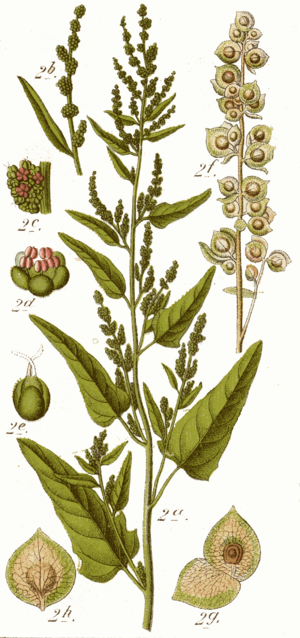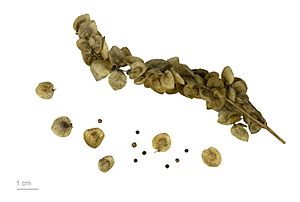Atriplex hortensis facts for kids
Quick facts for kids Atriplex hortensis |
|
|---|---|
 |
|
| A painting from 1796 showing Garden Orache | |
| Scientific classification | |
| Genus: |
Atriplex
|
| Species: |
hortensis
|
Atriplex hortensis, often called garden orache, red orache, or simply orache, is a plant used as a leaf vegetable. It is also known as mountain spinach or French spinach. This plant was very common before spinach became popular. People still grow it today as a good choice for warm weather, especially when spinach might not grow well. Garden orache comes from Asia and Europe. It now grows naturally in many other places like Canada, the United States, Australia, and New Zealand.
What Does Garden Orache Look Like?
Garden orache is a strong annual plant, meaning it grows from seed, flowers, and dies within one year. It has a straight stem with branches. The plant can grow from about two to six feet tall. Its height depends on the type of orache and the soil it grows in.
The leaves have different shapes, but they are usually somewhat long and thin. They taste a little bit sour. The flowers are small and not very noticeable. They can be greenish or reddish, often matching the color of the plant's leaves. The seeds are small and black. Each seed is covered by a thin, light-yellow layer. These seeds can grow into new plants for up to three years. You can find varieties of garden orache with red, white, or green leaves.
How Do People Use Garden Orache?
Garden orache tastes a bit like spinach, with a slightly salty flavor. You can eat the leaves cooked or raw in salads. In the past, green orache leaves were used in Italy to add color to pasta. People often use this plant to balance the sour taste of other plants like sorrel.
Garden orache was commonly grown in Mediterranean areas a long time ago. However, spinach later became the more popular leafy vegetable. Today, garden orache is a good choice for growing in warm weather. This is because it can handle heat better than spinach. It also takes longer to "bolt," which means it won't go to seed too quickly when it's hot.
Gallery
-
Dried, pressed specimen from the University of Neuchâtel
See also
 In Spanish: Armuelle de huerta para niños
In Spanish: Armuelle de huerta para niños





